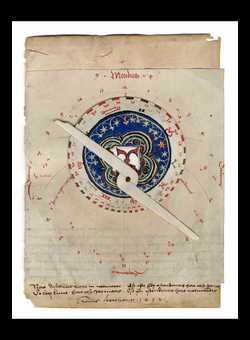| Date | 1492 |
| Maker | Hans Herghamer |
| Place | Germany |
| Material | Paper |
| Inventory no. | 91897 |
| Acquisition | Acquired by exchange from
Ernst Weil in 1954 |
This astrolabe is a rare {?} representative in the
collection of what was once the very common practice of
making instruments from ephemeral materials, with handwritten
scales, for personal use or as a learning exercise. Most
large manuscript libraries contain items of this kind, bound
into manuscript tomes; but their survival otherwise has been
extremely limited, and they are very little represented in
collections of scientific instruments.
This one survived because it had been stuck into a
contemporary printed book (Johannes Angelus,
Astrolabium, 1488). The Museum acquired it from a
dealer who had removed it from the book and sold the book
separately.
It is made of a piece of vellum attached to a slightly
larger piece of paper. The rule is
also of paper. And instead of a conventional rete there
is a paper volvelle consisting of the ecliptic
circle only, with its centre filled by a colourful design
incorporating an armorial motif. The maker, who signs 'Hanns
Herghamer' (the modern German surname Herkamer), is an
otherwise unknown amateur or scholar who obviously made it
for his own use.
View all
images for this astrolabe
View
detailed provenance for this astrolabe
Mater
The mater and limb are of other construction.
The
mater is a
piece of vellum that has been pasted to a piece of paper. The
paper extends below the vellum and bears a short inscription.
Scales on the limb: equal hours scale.
The limb is inscribed:
with a direction marked as Meridies
(North). Written in red ink. with a direction marked as
Occidens (West). Written in red ink. with a direction marked
as Septentrio (South). Written in red ink. with a direction
marked as Oriens (East). Written in red ink. with a
miscellaneous marked as Nota distantia lune in nativitate.
Est ipse gradus ascendentis hora casus spermatis (Note the
place of the moon at the birth. That is the degree of the
ascendent at the time of conception). with a miscellaneous
marked as Et locus lune hora casus spermatis. Est gradus
ascendentis hora nativitatis (And the location of the moon at
the moment of conception is the degree of the ascendent at
the time of birth.). with a maker's signature marked as Hans
Herghamer 1492.
More
information
Back
The verso side of the paper is blank, though
shows marks from the book it was once in. The back contains 0
scales.
More
information
Rete, Pin
The rete contains 0 stars. The zodiac on the rete is
labelled: ♈ , ♉ , ♊ , ♋ , ♌ , ♍ , ♎ , ♏ , ♐ , ♑ , ♒ , ♓.
The rete contains 1 scale of the following type:
Ecliptic.
The rete is attached using a pin. More information
Rules & Alidades
| Type |
Details |
| Rule | Double-ended, counter-changed.
|
More
information


